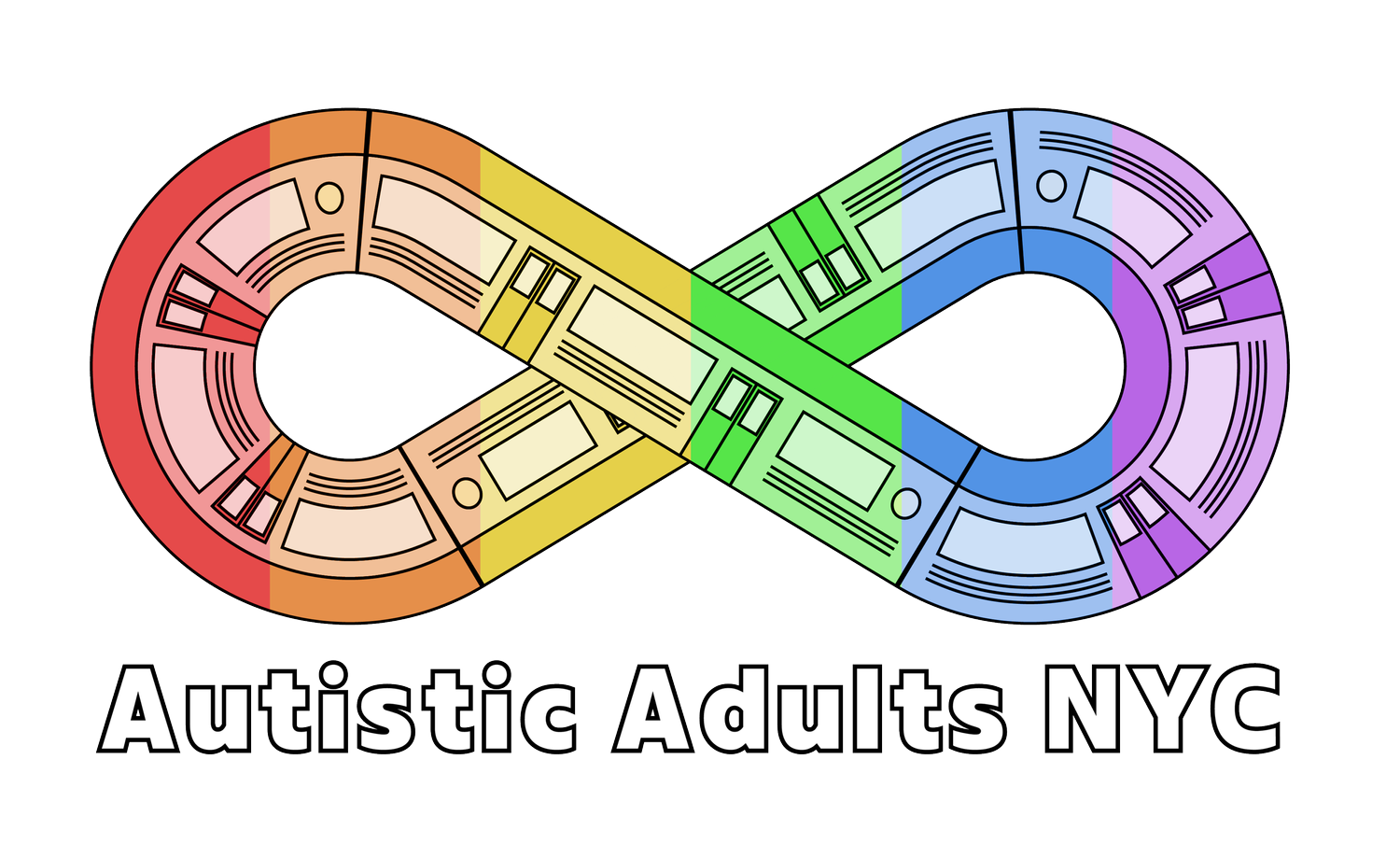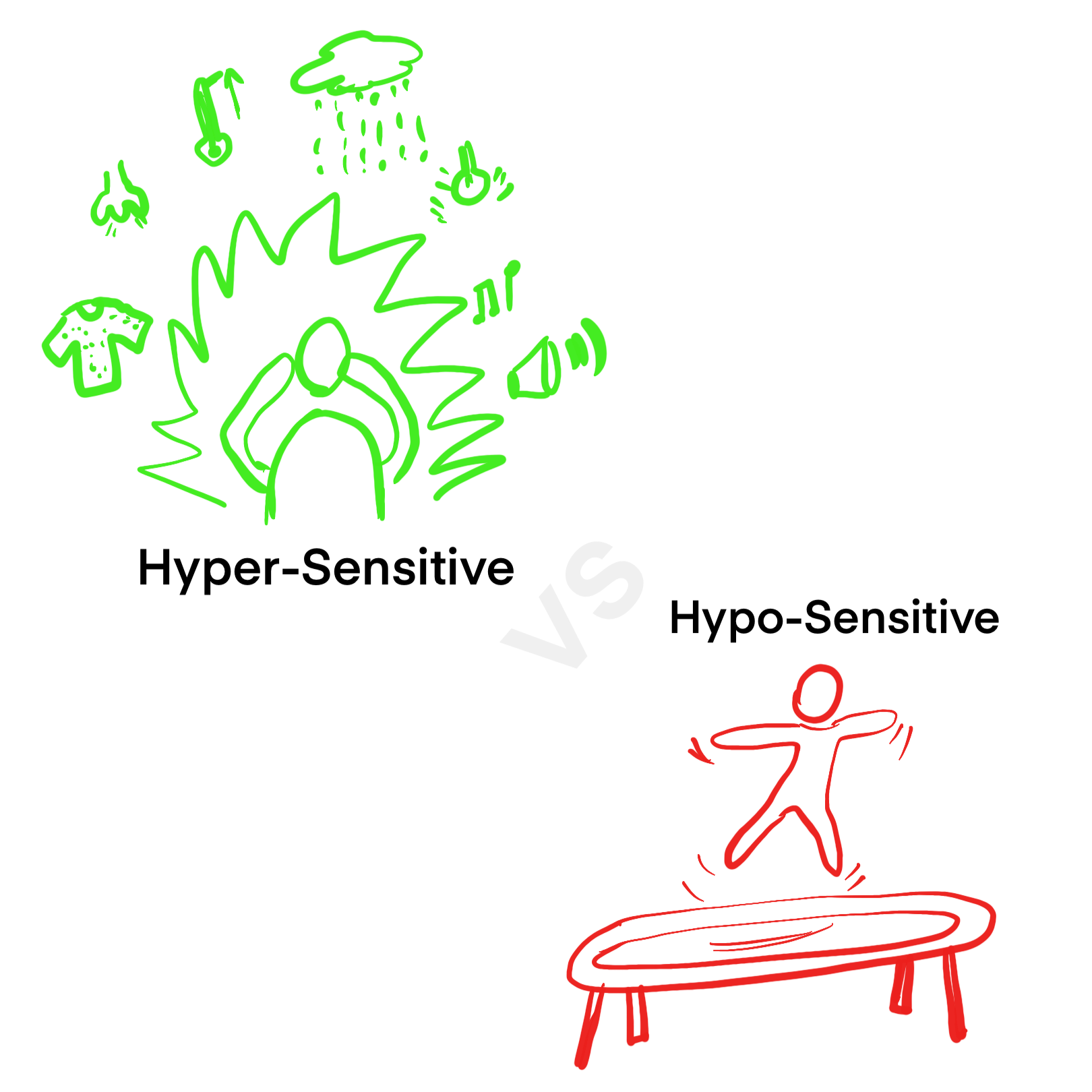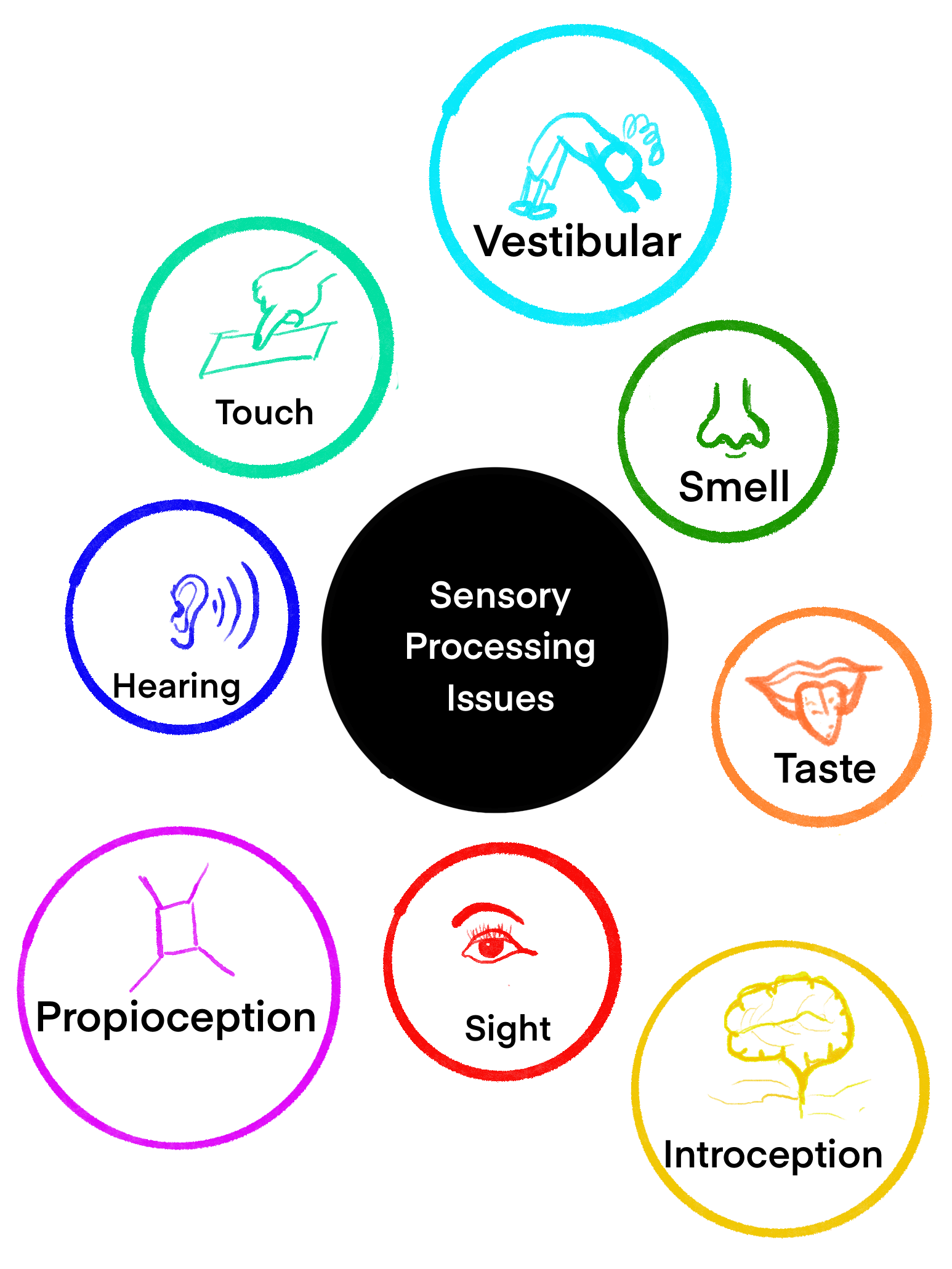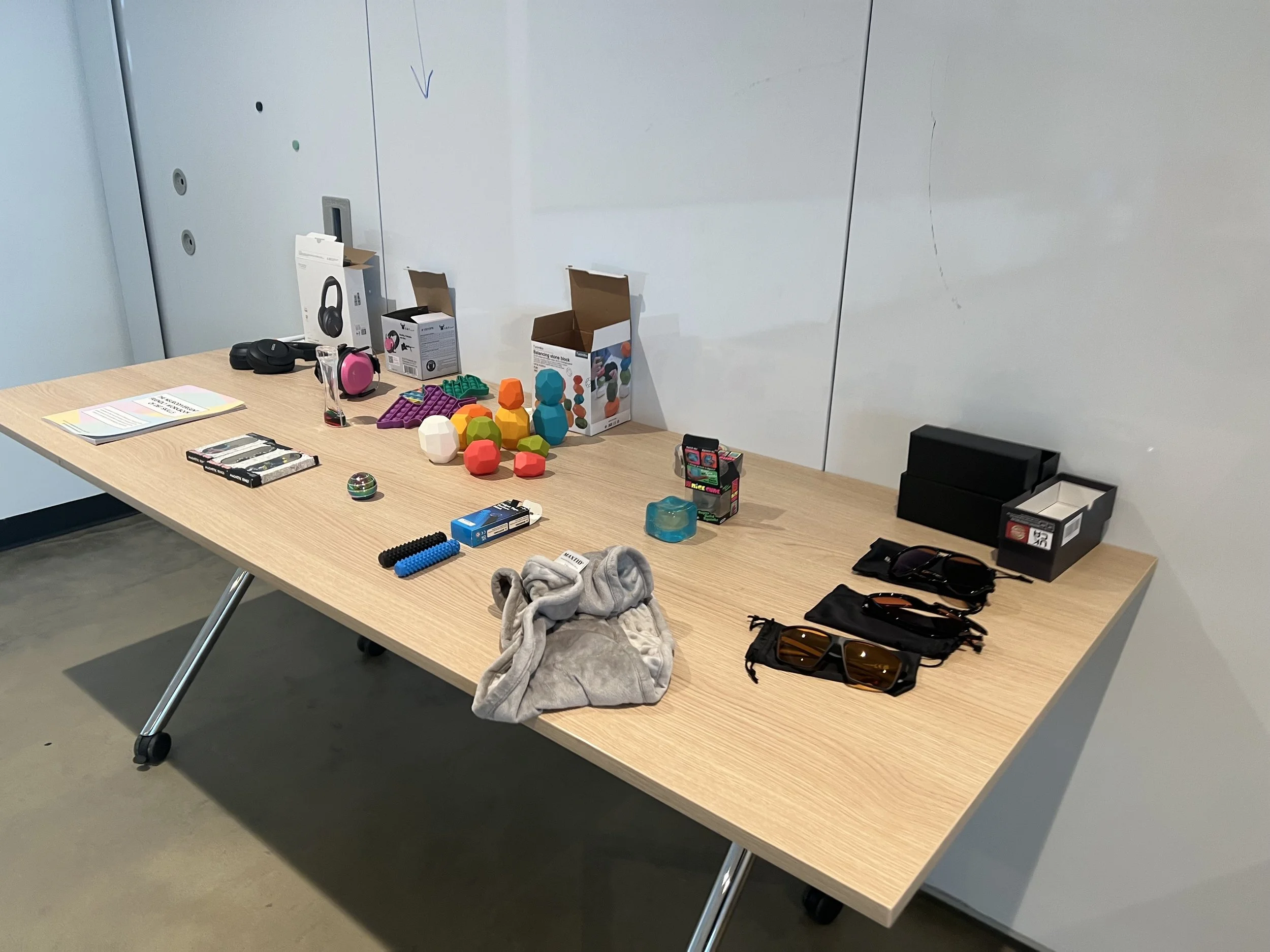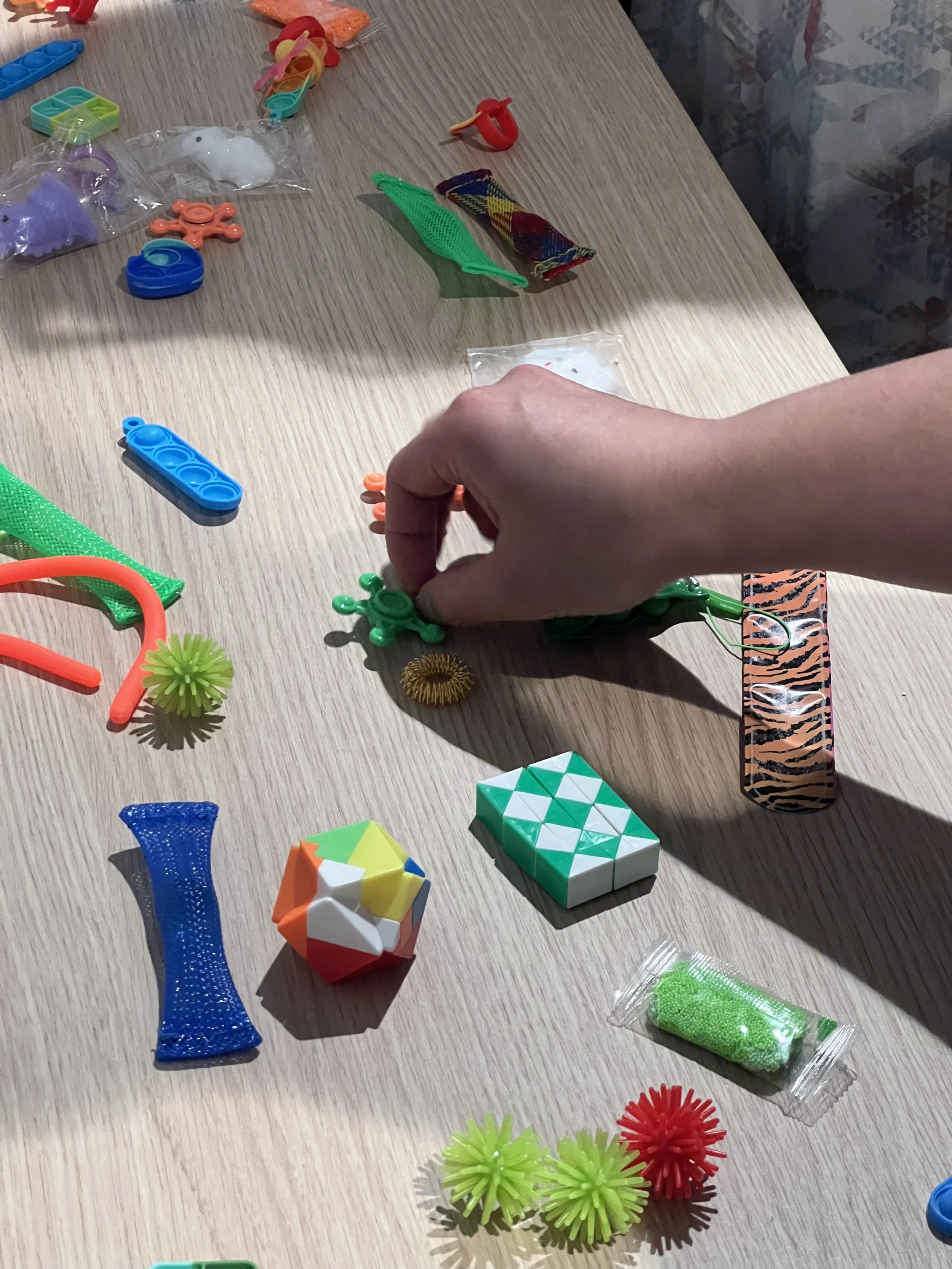As Autistic people, we may experience the world around us differently. Loud sounds or bright lights might make us feel uncomfortable, or maybe, we like to seek out interesting and strong flavors, like spinning around or going on rollercoasters. This resource goes into the “Autistic Sensory Experience” and dives into terms like “sensory processing issues”, “hyper/hypo reactive,” and other words often used to describe our sensory experience. This page includes a recording of a workshop we hosted delving into the topic, a written summary of some of its content, and a list of some of our favorite sensory tools.

View a recording from our Sensory Experience Workshop in August 2025! The slideshow can be found on our workshop slideshows page here.
What are “Sensory Processing Issues”?
Sensory processing issues are challenges with how the brain processes and responds to sensory input, such as sounds, smells, touch, etc. Some may feel overwhelmed with the amount of senses they are encountering, or the opposite, underwhelmed or under-reactive to sensory input. For example, a busy and loud environment can be overwhelming and make one feel uncomfortable. Or, on the contrary, lack of sound might make someone feel uneasy, and they may make sounds themselves as a way to self-regulate and find balance.
Those with Dyspraxia, which affects motor skills, might encounter sensory processing difficulties that make coordination and navigating their environment more challenging.
Those with Attention Deficit Hyperactivity Disorder (ADHD) may experience heightened sensitivity to noise, touch, or movement, which can make it difficult to focus or stay regulated in stimulating environments.
Sensory Processing Disorder (SPD), is a condition characterized by trouble receiving and responding to information from the senses.
Individuals who’ve experienced a Traumatic Brain Injury (TBI) may develop sensory processing differences, such as difficulty tolerating bright lights, loud sounds, or certain textures.
Who has “Sensory Processing Issues”?
Difficulty with sensory processing is not exclusive to autism. Additionally, not all Autistic people experience difficulty with sensory processing. Sensory differences can appear in a variety of other conditions -
It is essential to note that while sensory processing can play a role in Autism Spectrum Disorder (ASD), it is not required for a diagnosis. The DSM-5 (Diagnostic and Statistical Manual of Mental Disorders, 5th edition) includes sensory differences as one possible indicator of autism under its criteria for restricted, repetitive patterns of behavior. Only 2/4 indicators need to be present for a diagnosis.
Here’s how the DSM-5 includes sensory differences Under Criterion B (restricted, repetitive patterns of behavior) - Hyper- or hyporeactivity to sensory input or unusual interest in sensory aspects of the environment (e.g. apparent indifference to pain/temperature, adverse response to specific sounds or textures, excessive smelling or touching of objects, visual fascination with lights or movement).
Hyper- vs Hyporeactive
Hyper-reactive:
Hyper-reactivity refers to heightened responses to sensory input, also known as “overstimulation”, “hyper-sensitive” or “sensory overload.”
Overstimulation is a state of being that is caused by too much sensory input. Being overstimulated occurs when one is overwhelmed by information from their senses and struggles to process their environment.
This might show up as music feeling too loud, lights seeming too bright, or smells becoming overwhelming. When this happens, it might feel like a traffic jam of information, where one’s brain can’t process everything fast enough. One might react by covering their ears, squinting, or withdrawing to cope.
Some examples are:
Being bothered by bright lights
Feeling overwhelmed with sounds on the train
Having a negative reaction to strong smells
Hypo-reactive:
Hypo-reactivity refers to feeling under-reactive to sensory stimuli. This might be referred to as “under-stimulation” or “hypo-sensitive.” In response, one might be “sensory seeking,” or have a craving for more sensory input, feeling the need to constantly explore and seek out more sensory information from the world around them.
Those experiencing hypo-reactivity may seek out loud music, feel the need to touch textures constantly, or stare at lights. They need more stimuli to feel engaged or stay focused.
Some examples are:
Spinning around
Rocking back and forth
Staring at lights
Going to concerts with loud music
Exploring extremely spicy or new flavors
How Sensory Processing Differences Can Affect the 8 Senses:
Vision
Bright lights can feel overwhelming.
Some people may seek out flashing or moving lights.
Smell
Strong odors like smoke can be uncomfortable.
Others may not notice or react much to strong smells.
Touch
Clothing tags or rough fabrics can feel painful.
Some people may seek extra pressure or touch.
Taste
Certain foods may taste too strong or unpleasant.
Others may crave very strong or spicy flavors.
Hearing
Loud or sudden sounds can be distressing.
Some people may prefer very loud music or specific sounds.
Vestibular (sense of gravity, inner ear, balance)
Swings, slides, or roller coasters may feel uncomfortable.
Others may enjoy spinning, jumping, or intense movement.
Proprioception (awareness of body positions & movement, or, the ability to know where your body parts are without needing to look)
Difficulty sensing where your body is and appearing clumsy.
Purposely bumping into things.
Interoception (internal body awareness)
The sensation of your heart beating or breathing feeling overwhelming.
Not realizing you’re hungry, thirsty, or need the bathroom.
What is the Autistic Sensory Experience?
Many of us don’t like to view our experience through the deficit lens or through medical terminology like “sensory processing issues.” Additionally, our experience goes beyond just difficulty with being overstimulated. Being hyper-sensitive to certain senses can have some benefits! Autistic people are three times as likely to experience synesthesia. Autistic people have an increased auditory perceptual capacity, meaning we might be better at music or certain auditory tasks. Some autistic people view our sensory differences through the lens of monotropism, meaning we may best thrive by processing 1 source of input (this case, sensory input) at one time.
There are a lot of different ways to experience sensory input as Autistic people. Read the articles below, and we explore you to define your own Autistic sensory experience!
Exploring the Intriguing Connection Between Synaesthesia and Autism - Reframing Autism
Managing your Sensory Experience
Sensory differences can make the world feel overwhelming. Bright lights, loud sounds, strong smells, or certain textures may be hard to manage, while other times we might not get enough sensory input. Adjusting the environment, such as dimming the lights or using an air purifier, can help, but it’s not always possible.
When you can’t change the environment, it’s useful to have techniques to regulate either sensory overload or under-stimulation. It’s good to create a personal list of strategies that work for you.
With tools: Items you can carry with you in case of sensory overload.
Without tools: Strategies you can use anytime, even if you don’t have anything on hand.
Regulating With Tools:
Without any special equipment, there are simple ways to help ground oneself. For example:
Yoga can help center the mind and body.
Meditation and breathing exercises are excellent for calming the nervous system.
Body scan techniques, where you check in with each part of your body, can help reduce anxiety.
Going outside and enjoying a quiet walk can also be a great reset.
In general, a lot of DBT grounding techniques can help regulate sensory problems
Regulating Without Tools:
For those who want to carry sensory aids, there are plenty of tools available:
Noise-Canceling Headphones can block out disruptive sounds.
Weighted Blankets or Sensory Wraps provide a sense of security and calm.
Stim Toys and Chewelry can offer tactile stimulation.
Color Filtering Glasses can help with visual sensitivities.
Sensory-friendly clothing can reduce discomfort from fabrics or seams.
There are many strategies to cope with sensory challenges, but it’s about finding what works best for you. Whether you need to carry your sensory tools with you or engage in a grounding exercise, the goal is to find balance and comfort in a world full of sensory stimulation.

View our favorite sensory tools here! Many of these we used these at our last sensory workshop.
Have questions? Reach out to info@autisticadultsnyc.org
Do you find our resources useful? Consider making a donation to keep our website and organization alive! - SUPPORT AUTISTIC ADULTS NYC
